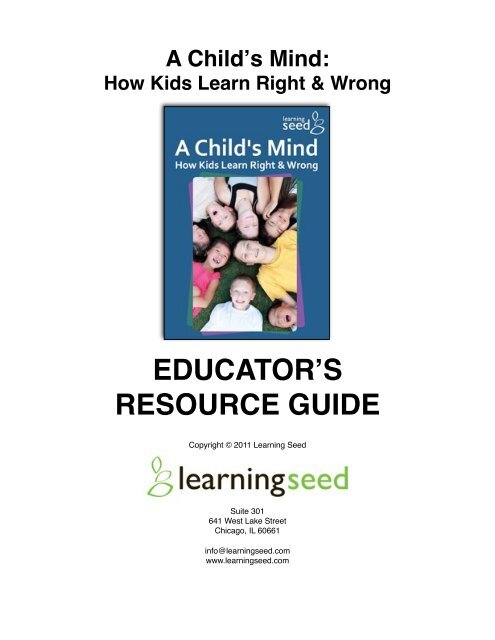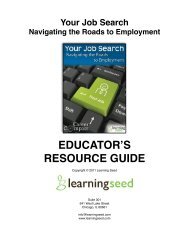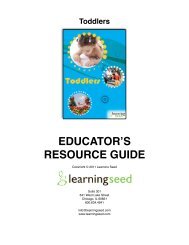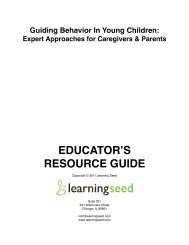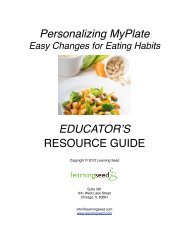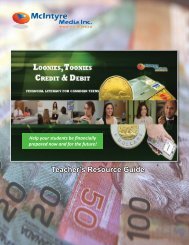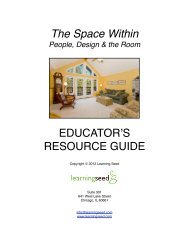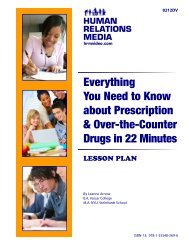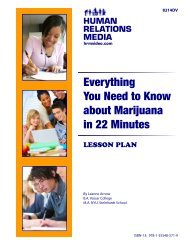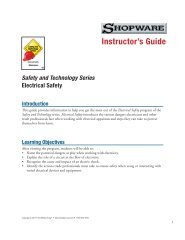EDUCATORʼS RESOURCE GUIDE - Learning Seed
EDUCATORʼS RESOURCE GUIDE - Learning Seed
EDUCATORʼS RESOURCE GUIDE - Learning Seed
Create successful ePaper yourself
Turn your PDF publications into a flip-book with our unique Google optimized e-Paper software.
A Childʼs Mind:<br />
How Kids Learn Right & Wrong<br />
<strong>EDUCATORʼS</strong><br />
<strong>RESOURCE</strong> <strong>GUIDE</strong><br />
Copyright © 2011 <strong>Learning</strong> <strong>Seed</strong><br />
Suite 301<br />
641 West Lake Street<br />
Chicago, IL 60661<br />
info@learningseed.com<br />
www.learningseed.com
Legal Niceties<br />
This Resource Guide<br />
Copyright © 2011 <strong>Learning</strong> <strong>Seed</strong>.<br />
This teaching guide is copyrighted according to the terms of the Creative Commons non-commercial license<br />
(http://creativecommons.org/licenses/by-nc/2.5/). It may be reproduced, in its part or its entirety, for classroom use.<br />
No part of this guide may be reproduced for sale by any party.<br />
You are free:<br />
· to copy, distribute, display, and perform the work.<br />
· to make derivative works.<br />
Under the following conditions:<br />
· Attribution. You must attribute the work to <strong>Learning</strong> <strong>Seed</strong>.<br />
· Noncommercial. You may not use this work for commercial purposes.<br />
· For any reuse or distribution, you must make clear to others the license terms of this work.<br />
· Any of these conditions can be waived if you get permission from the copyright holder.<br />
Resource Guide Credits<br />
Writer: Kathleen Ryan<br />
Editor: Kari McCarthy<br />
Copy Editors: Jennifer Smith, EJ Green, Michael Robbins<br />
The Video<br />
Copyright © 2011 <strong>Learning</strong> <strong>Seed</strong>.<br />
This video program is protected under U.S. copyright law. No part of this video may be reproduced or transmitted<br />
by any means, electronic or mechanical, without the written permission of the Publisher, except where permitted by<br />
law.<br />
DVD LS-1346-11-DVD ! ISBN 1-55740-585-9<br />
Closed Captioning<br />
This program is closed-captioned.<br />
Questions, suggestions or comments?<br />
Email us at info@learningseed.com or call Jennifer Smith: 800.634.4941<br />
A Child's Mind: How Kids Learn Right & Wrong<br />
2 Copyright 2011 <strong>Learning</strong> <strong>Seed</strong>
Table of Contents<br />
Program Summary..............................................................................................................................................4<br />
National Standards.............................................................................................................................................5<br />
Additional Resources.........................................................................................................................................6<br />
Lesson Plans<br />
! Guide and Create Expectation:<br />
! Lesson 1a: Moral Dilemmas: What Would You Do? (Survey)......................................................................7-8<br />
! OR<br />
! Lesson 1b: Unit Pre-test (Fill-in-the-Blank)...............................................................................................9<br />
! Define and Interpret Information:<br />
! Students watch the video A Child's Mind: How Kids Learn Right & Wrong during this lesson.<br />
! Lesson 2: Who Said That? (Independent Practice)..............................................................................10-12<br />
! AND<br />
! Lesson 3: What Can We Do? (Collaborative <strong>Learning</strong>).............................................................................13<br />
! Generate and Differentiate Ideas:<br />
! Lesson 4: What Did I Do? (Journal Activity)...............................................................................................14<br />
! AND<br />
! Lesson 5: How Do They Compare? (Venn Diagram)..................................................................................15<br />
! Develop and Evaluate Performance:<br />
! Lesson 6a: Meet a Theorist (Mock Interview)...........................................................................................16<br />
! OR<br />
! Lesson 6b: Unit Post-test (Fill-in-the-Blank)............................................................................................17<br />
Appendix.................................................................................................................................................18<br />
! Student Worksheets<br />
! Rubric<br />
! Student Glossary<br />
A Child's Mind: How Kids Learn Right & Wrong<br />
3 Copyright 2011 <strong>Learning</strong> <strong>Seed</strong>
Program Summary<br />
This program explores the topic of moral development and how it impacts human behavior. We describe the theories of<br />
Jean Piaget, Lawrence Kohlberg, Carol Gilligan, Albert Bandura, and Elliot Turiel. We also explain the concept of theory of<br />
mind. Examining moral dilemmas helps us to understand how children develop in the moral domain as they mature.<br />
Viewers see examples of how children of various ages will typically answer moral dilemmas and how adults can guide the<br />
moral development of children.<br />
Unit Teaching points:<br />
1. Moral development is the process through which individuals develop attitudes and behaviors toward others.<br />
2. Morals are based on social and cultural norms, rules and laws.<br />
3. A lack of moral development can lead to a variety of negative consequences, including socially unacceptable<br />
behavior, academic issues, inability to make friends, alcohol and drug problems, and criminality.<br />
4. Piagetʼs theory of moral development is characterized by a transition from heteronomous to autonomous moral<br />
thinking.<br />
5. Lawrence Kohlberg expanded on Piagetʼs work. His theory has stages through which people progress, but the<br />
process is gradual and has more transitions.<br />
6. Elliot Turiel used domain theory to explain childrenʼs moral development, their adherence to social conventions, and<br />
their views of themselves and others.<br />
7. Albert Banduraʼs theory asserts that most human behavior is learned through modeling.<br />
8. Theory of mind relates to the ability to see the world from another personʼs perspective -- something that very young<br />
children cannot do.<br />
9. Understanding moral development can help adults to better guide childrenʼs behavior.<br />
Related <strong>Learning</strong> <strong>Seed</strong> Programs: !<br />
Guiding Behavior In Early Childhood: A Positive Plan for Discipline and Caregiving<br />
Disciplining Kids: Without Screaming and Scolding<br />
Rules, Rituals, Routines<br />
A Child's Mind: How Kids Learn Right & Wrong<br />
4 Copyright 2011 <strong>Learning</strong> <strong>Seed</strong>
National Standards<br />
National Standards for High School Psychology<br />
IA-1. Contemporary perspectives used by psychologists to understand behavior and mental processes in context<br />
IA-3. Research strategies used by psychologists to explore behavior and mental processes<br />
IIIA-1. Development as a lifelong process<br />
IIIA-3. Theories of development<br />
IIIA-4. Issues surrounding the developmental process (nature/nurture, continuity/discontinuity, stability/instability,<br />
critical periods)<br />
IVA-4. Components of cognitive learning<br />
NASAFACS - National Standards for Family and Consumer Sciences<br />
4.0 Education and Early Childhood<br />
! 4.2 Analyze developmentally appropriate practices to plan for early childhood, education, and services<br />
! 12.0 Human Development<br />
! 12.1 Analyze principles of human growth and development across the life span<br />
! 12.2 Analyze conditions that influence human growth and development<br />
A Child's Mind: How Kids Learn Right & Wrong<br />
5 Copyright 2011 <strong>Learning</strong> <strong>Seed</strong>
Additional Resources<br />
Educating Moral People: A Caring Alternative to Character Education<br />
Nel Noddings, New York: Teachers College Press, 2002.<br />
Handbook of Moral and Character Education<br />
Edited by Larry P. Nucci, Darcia Narvaez. New York: Routledge, 2008<br />
Moral Questions in the Classroom: How to Get Kids to Think Deeply about Real Life and their School Work.<br />
Katherine G. Simon. Yale University Press, 2001.<br />
Nice is Not Enough. Larry Nucci. Merrill, Upper Saddle River, NJ, 2008<br />
Character Counts: charactercounts.org<br />
Journal of Moral Education<br />
The Journal of Moral Education, Published by Routledge, New York NY.<br />
A Child's Mind: How Kids Learn Right & Wrong<br />
6 Copyright 2011 <strong>Learning</strong> <strong>Seed</strong>
Lesson Plan 1a (page 1 of 2)<br />
Purpose: " Guide & Create Expectations<br />
Name: " Moral Dilemmas: What Would You Do?!<br />
Type: " Survey<br />
Est. Length " 40 minutes<br />
Lesson Summary<br />
Students use scenario-based activities to become familiar with moral dilemmas and how they can be<br />
used to understand moral development.<br />
Lesson Materials<br />
• Copies of “Moral Dilemmas: What Would You Do?”(Worksheet A in the Appendix)<br />
• Pen/Pencil<br />
• Computer with online access<br />
:<br />
• Printer<br />
Lesson Objective(s)<br />
A Child's Mind: How Kids Learn Right & Wrong<br />
• Students will understand the definition of moral dilemma.<br />
• Students will understand the application of moral dilemmas in the field of moral development.<br />
• Students will respond personally to moral dilemmas.<br />
• Students will differentiate between responses to moral dilemmas based on age.<br />
7 Copyright 2011 <strong>Learning</strong> <strong>Seed</strong>
Lesson Plan 1a (page 2 of 2)<br />
(Estimated Length: 40 minutes)<br />
I. Lesson Set-up (10 minutes)<br />
1. Before class, access the following websites and choose 5 dilemmas that are appropriate for your class:<br />
! Good Character! http://www.goodcharacter.com/dilemma/archive.html<br />
Quose !! http://www.quose.com<br />
2. At the beginning of class, share with students the following:<br />
• Moral dilemmas can be used to assess how children think about moral situations at various stages of<br />
their development.<br />
• Examining moral dilemmas is useful to understand how moral development takes place, and also to<br />
inform caregiving adults as to what is developmentally appropriate for children at various ages.<br />
3. Read each dilemma to the class and probe for responses. Ask students why they feel as they do. Represent<br />
responses visually on white board/projector etc.<br />
II. <strong>Learning</strong> Activity (20 minutes)<br />
1. Explain to students that they will be reading various dilemmas and answering questions about how they would<br />
handle each one.<br />
2. Distribute copies of “Moral Dilemmas: What Would You Do?” (Worksheet A in the Appendix) for each student<br />
to complete independently.<br />
3. Facilitate a class discussion about each dilemma and their responses.<br />
III. Closure: Discussion (10 minutes)<br />
Have a class discussion about Moral Development. The five questions below should guide your daily closing<br />
discussion.<br />
Answer Key<br />
1. What is moral development?<br />
2. How can moral development be assessed?<br />
3. Why is awareness of moral development important to our society?<br />
4. How can adults foster positive moral development in children?<br />
5. How could a lack of moral development lead to negative consequences?<br />
1. 3-year-oldʼs answer: “JOHN - He broke so many!”<br />
2. A. 4-year-old ! “Itʼs bad to steal. She will be punished.”! ! ! ! ! !<br />
B. 7-year-old ! “She should return it...but if she had no other way to get a<br />
present she could use that money...if she doesnʼt get caught.”! ! ! !<br />
!<br />
D. 17-year-old! “She should return it. If it were mine, I would hope someone would return it to me. !<br />
! ! ! Keeping it would be stealing and we canʼt condone stealing or what would our<br />
! ! ! society be? She should give it back for the good of society.”<br />
C. 9-year-old ! “She should try to find the owner and give it back. Whoever lost it deserves it back. !<br />
! ! ! People canʼt just go around taking what isnʼt theirs!<br />
3. Moral Rule; Social Rule<br />
A Child's Mind: How Kids Learn Right & Wrong<br />
8 Copyright 2011 <strong>Learning</strong> <strong>Seed</strong>
Lesson Plan 1b (Alternative)<br />
Purpose: " Guide & Create Expectations<br />
Name: " Unit Pre-test<br />
Type: " Fill-in-the-Blank<br />
Est. Length: " 20 minutes<br />
As an alternative to Lesson 1a: “Moral Dilemmas: What Would You Do?” you can guide and create student expectations<br />
by using the Pre-test found in the Appendix (Worksheet 1b).<br />
Answer Key<br />
Moral development is the process through which individuals develop attitudes and behaviors toward others. It is based<br />
on social and cultural norms, rules and laws. The lack of moral development can lead to a variety of negative<br />
consequences - including socially unacceptable behavior, academic issues, inability to make friends, alcohol and drug<br />
problems, and criminality.<br />
Jean Piagetʼs theory of moral development is characterized by a transition from heteronomous to autonomous moral<br />
thinking. Lawrence Kohlberg was an American developmental theorist who expanded on Piagetʼs work but felt that the<br />
process was more gradual and had more transitions that went from externally controlled behavior to internally controlled<br />
behavior. Carol Gilligan created a theory similar to Kohlberg, but instead of focusing on the growth of cognitive abilities as<br />
the primary driver of moral development, she saw the growth of a sense of self as the key to greater moral awareness.<br />
Elliot Turiel is an American theorist who believes that a moral domain, a social domain, and a psychological domain<br />
evolve in a parallel way - all occurring at once. Albert Bandura is a Canadian psychologist who examined moral<br />
development through social learning theory, which asserts that most human behavior is learned through modeling.<br />
Theory of mind is a philosophical belief that moral development is affected by the ability to see the world from another<br />
personʼs perspective.<br />
A Child's Mind: How Kids Learn Right & Wrong<br />
9 Copyright 2011 <strong>Learning</strong> <strong>Seed</strong>
Lesson Plan 2 (page 1 of 2)<br />
Purpose: " Define & Interpret Information<br />
Name: " Who Said That?<br />
Type: " Independent Practice<br />
Est. Length: " 40 minutes<br />
Lesson Summary<br />
As students watch A Child's Mind: How Kids Learn Right & Wrong they will complete Worksheet C, “Who Said That?”<br />
Student will write the name of a theorist that matches each stated moral development concept given.<br />
Lesson Materials<br />
• Copies of “Who Said That?” (Worksheet C in the Appendix)<br />
• Pen/Pencil<br />
• Notebook paper<br />
• Video: A Child's Mind: How Kids Learn Right & Wrong<br />
Lesson Objective(s)<br />
A Child's Mind: How Kids Learn Right & Wrong<br />
• Students will understand key concepts of the moral developmental theories of Jean Piaget, Lawrence Kohlberg,<br />
Carol Gilligan, Elliot Turiel, Albert Bandura, and theory of mind.<br />
• Students will know what critics had to say about each theoristʼs findings.<br />
• Students will compare and contrast various theories and theorists.<br />
10 Copyright 2011 <strong>Learning</strong> <strong>Seed</strong>
Lesson Plan 2 (page 2 of 2)<br />
(Estimated Length: 40 minutes)<br />
I. Lesson Set-up (5 minutes)<br />
BEFORE the video:<br />
1. Ask students to respond to following in their journals:<br />
! Name 5 people in any field who you believe are experts at something.<br />
! For each, name:<br />
• their area of expertise,<br />
• what qualifies them as an expert,<br />
• how they can help other people with their expertise.<br />
2. Inform students that they will be learning about 5 prominent theorists who are considered experts in the field<br />
of moral development during the video they are about to watch.<br />
II. <strong>Learning</strong> Activity (30 minutes)<br />
1. Distribute “Who Said That?” (Worksheet C in the Appendix). Instruct students watch the program as they<br />
complete the worksheet.<br />
2. Preview the worksheet and pronounce the names for the students.<br />
3. Explain that there are several quotes matching the main ideas of each theoristʼs work. Have students read<br />
each one aloud.<br />
4. Explain they should match the theorist to the quote as they watch the video.<br />
5. Begin the film and have students work independently.<br />
III. Closure: Discussion (5 minutes)<br />
Have a class discussion about Moral Development. The five questions below should guide your daily closing<br />
discussion.<br />
1. What is moral development?<br />
2. How can moral development be assessed?<br />
3. Why is awareness of moral development important to our society?<br />
4. How can adults foster positive moral development in children?<br />
5. How could a lack of moral development lead to negative consequences?!<br />
A Child's Mind: How Kids Learn Right & Wrong<br />
11 Copyright 2011 <strong>Learning</strong> <strong>Seed</strong>
Who Said That? Answer Key<br />
1. “The ability to see from anotherʼs perspective is part of the cognitive maturity that is linked to moral development.”<br />
________________________________ (Jean Piaget)<br />
2. “Moral development is characterized by a transition from heteronomous to autonomous moral thinking.”<br />
! _______________________________ (Theory of Mind)<br />
3. “Violent tendencies in children grow as a result of observing othersʼ violent behavior personally or through the media<br />
or environment.”<br />
________________________________ (Albert Bandura)<br />
4. “This theorist put too much emphasis on thought as opposed to actual behavior. He does not cite the influence of the<br />
parentsʼ role in moral development, and progression through his stages is not always exactly as he predicts.”<br />
________________________________ (Critics of Kohlberg)<br />
5. “This theorist is mistaken in the idea that the domains of morality, social convention and personal autonomy are<br />
separate from and develop parallel to each other. They must be interrelated!”<br />
________________________________ (Critics of Turiel)<br />
6. “My theory has 3 levels --Preconventional, Conventional, and Postconventional-- that are made up of 6 stages.”<br />
________________________________ (Lawrence Kohlberg)<br />
7. “The growth of a sense of self is the key to greater moral awareness.”<br />
________________________________ (Carol Gilligan)<br />
8. “Some young children are not as egocentric as this theorist believed them to be.”<br />
________________________________ (Critics of Piaget)<br />
9. “Though moral, social and psychological are distinct developmental areas, they are often connected. It is the childʼs<br />
! ! attempts to understand how they relate to one another that allow moral development to take place.”<br />
________________________________ (Elliot Turiel)<br />
10. “This theoristʼs ideas donʼt take into account that studies have shown that both men and women use both justice and<br />
! ! care dimensions in their moral reasoning.”<br />
________________________________ (Critics of Carol Gilligan)<br />
11. “Social learning theory doesnʼt take into account an individualʼs genetic and cognitive predispositions. There have<br />
been conflicting findings regarding whether or not television and video game violence causes children to act violently.”<br />
________________________________ (Critics of Bandura)<br />
A Child's Mind: How Kids Learn Right & Wrong<br />
12 Copyright 2011 <strong>Learning</strong> <strong>Seed</strong>
Lesson Plan 3<br />
Purpose: " Define & Interpret Information<br />
Name: " What Can We Do?<br />
Type: " Collaborative <strong>Learning</strong><br />
Est. Length: " 40 minutes<br />
Lesson Summary<br />
Students create a plan of action to help guide a childʼs moral development.<br />
Lesson Materials<br />
• Copies of “What Can We Do?” (Worksheet D in the Appendix)<br />
• Pen/Pencil<br />
• Notebook paper/Journal<br />
Lesson Objective(s)<br />
• Students understand how moral dilemma situations are important to moral development.<br />
• Students apply suggestions for how to guide a childʼs moral development.<br />
I. Lesson Set-up (10 minutes)<br />
Ask students to respond to the following in their journals:<br />
1. Write about a time when you asked for and received someoneʼs advice because you struggled with deciding<br />
what would be the “right” thing to do.<br />
2. How was it helpful or not helpful?<br />
II. <strong>Learning</strong> Activity (25 minutes)<br />
1. Distribute “What Can We Do?” (Worksheet D) and review the situations shown in A Child's Mind: How Kids<br />
Learn Right & Wrong in which parents and caregivers could help foster moral development in children.<br />
2. Divide students into groups of three or four and tell each group should choose one scenario.<br />
3. Instruct each to brainstorm ideas for helping guide a childʼs behavior for each scenario.<br />
4. Create an action plan to help foster that behavior.<br />
5. Groups will share their plan with the class.<br />
III. Closure: Discussion (5 minutes)<br />
The five questions below should guide your daily closing discussion.<br />
1. What is moral development?<br />
2. How can moral development be assessed?<br />
3. Why is awareness of moral development important to our society?<br />
4. How can adults foster positive moral development in children?<br />
5. How could a lack of moral development lead to negative consequences?<br />
A Child's Mind: How Kids Learn Right & Wrong<br />
13 Copyright 2011 <strong>Learning</strong> <strong>Seed</strong>
Lesson Plan 4<br />
Purpose: " Generate & Differentiate Ideas<br />
Name: " What Did I Do?<br />
Type: " Journaling Exercise<br />
Est. Length: " 40 minutes<br />
Lesson Summary<br />
! Students will personalize the subject of moral development by reflecting and writing about what they remember<br />
! about the types of moral dilemmas that people face at various stages of their lives.<br />
Lesson Materials<br />
• Copies of “What Did I Do?”(Worksheet E in the Appendix)<br />
• White board or overhead projector to represent class discussion responses for all to see<br />
• Pen/Pencil<br />
• Notebook paper<br />
Lesson Objectives<br />
• Students will understand the importance of moral development to a personʼs early childhood development.<br />
• Students will apply suggestions regarding how adults can foster positive moral development in children.<br />
I. Lesson Set-up (10 minutes)<br />
1. Lead students through a brainstorming activity to identify moral dilemmas that most children face at each of<br />
the following stages: preschool, early elementary school, middle school, junior high, and high school.<br />
Example questions:<br />
What kinds of moral dilemmas do 3- and 4-year-olds face at home? At school? On the playground?<br />
2. Represent student ideas on an overhead, white board, chart paper, etc.<br />
II. <strong>Learning</strong> Activity (20 minutes)<br />
1. Distribute “What Did I Do?” (Worksheet E) and read it over completely with students.<br />
2. Tell the students they have 20 minutes to complete the exercise independently.<br />
3. Ask students to share their responses voluntarily.<br />
III. Closure: Discussion (10 minutes)<br />
The five questions below should guide your daily closing discussion.<br />
1. What is moral development?<br />
2. How can moral development be assessed?<br />
3. Why is awareness of moral development important to our society?<br />
4. How can adults foster positive moral development in children?<br />
5. How could a lack of moral development lead to negative consequences<br />
A Child's Mind: How Kids Learn Right & Wrong<br />
14 Copyright 2011 <strong>Learning</strong> <strong>Seed</strong>
Lesson Plan 5<br />
Purpose:" Generate & Differentiate Ideas<br />
Name:" How Do They Compare?<br />
Type:" Venn Diagram<br />
Est. Length:" 40 minutes<br />
Lesson Summary<br />
" Students will review the main ideas of developmental theorists using a website and then choose two theorists<br />
! to compare and contrast using a Venn diagram.<br />
Lesson Materials<br />
• Copies of “How Do They Compare?” (Worksheet F in the Appendix) for each student<br />
• Notebook Paper/Journal<br />
• Pencil/Pen<br />
:<br />
• Computer Online Access<br />
Lesson Objective(s)<br />
• Students will understand ideas of each developmental theorist.<br />
• Students will differentiate ideas by using direct comparison.<br />
• Students will understand how theories can be alike but still differ.<br />
I. Lesson Set-up (5 minutes)<br />
Instruct students to write in their journal about the following:<br />
Think of two people who have given you advice. Write about them and the advice they gave. Compare the ways<br />
they gave advice and the approaches they used to talk with you.<br />
II. <strong>Learning</strong> Activity (30 minutes)<br />
1. Direct students to the website: http://tigger.uic.edu/~lnucci/MoralEd/overview.html<br />
2. Direct them to choose two theorists<br />
3. Distribute “How Do They Compare?” (Worksheet F in the Appendix) and instruct the students to choose two<br />
theorists and fill in the Venn diagram to compare them.<br />
4. If time allows, students can share their comparisons with the class.<br />
III. Closure: Discussion (5 minutes)<br />
Have a class discussion about Moral Development. The five questions below should guide your daily closing discussion.<br />
1. What is moral development?<br />
2. How can moral development be assessed?<br />
3. Why is awareness of moral development important to our society?<br />
4. How can adults foster positive moral development in children?<br />
5. How could a lack of moral development lead to negative consequences?<br />
A Child's Mind: How Kids Learn Right & Wrong<br />
15 Copyright 2011 <strong>Learning</strong> <strong>Seed</strong>
Lesson Plan 6a - Assessment<br />
Purpose: ! Develop & Evaluate Performance<br />
Name: ! Meet a Theorist!<br />
Type: ! Mock Interview<br />
Est. Length: ! Two 40-minute sessions<br />
Assessment Materials<br />
• Copies of Worksheet G (in the Appendix) for each student<br />
• Notebook Paper<br />
:<br />
• Pencil/Pen<br />
• Computer Online Access<br />
Assessment Objective(s)<br />
• Students will show mastery of understanding the basic theories of moral development.<br />
• Students will show understanding of the importance of moral development at various stages of development.<br />
• Students will show their understanding of why moral development is important to a society.<br />
• Students will demonstrate how to apply moral developmental guidelines when working with children.<br />
• Students will explain how a lack of moral development could lead to negative consequences<br />
I. Lesson Set-up (10 minutes)<br />
Facilitate a discussion about what makes a good TV interview. Ask students to name a few famous people who<br />
are good at it (Oprah?). Ask students: “Why are they good? What types of questions get the best answers?”<br />
II. Assessment Activity (40 minutes—Two class periods)<br />
A Child's Mind: How Kids Learn Right & Wrong<br />
Summary:! Students will work in pairs to research a developmental theorist and then write questions and<br />
! ! answers for a mock interview that will be presented to the class.<br />
1. Divide students into pairs. Assign each group a developmental theorist or “Theorist who believes that theory<br />
of mind is the best theory of moral development.”<br />
2. Read through “Meet a Theorist” (Worksheet G) and field any questions about the assessment.<br />
3. Allow students 20 minutes to fill out the “Meet a Theorist” worksheet in class.<br />
4. Designate the last 20 minutes for groups to practice the mock interview they will present to class the next day.<br />
5. On the next day of class, each pair should present their interview to the class.<br />
16 Copyright 2011 <strong>Learning</strong> <strong>Seed</strong>
Lesson Plan 6b - Assessment (Alternative)<br />
Purpose: " Develop & Evaluate Performance<br />
Name: " Post-test!<br />
Type: " Fill-in-the-Blank<br />
Est. Length: " 30 minutes<br />
Unit Post-test Answer Key<br />
Moral development is the process through which individuals develop attitudes and behaviors toward others. It is based<br />
on social and cultural norms, rules and laws. The lack of moral development can lead to a variety of negative<br />
consequences including socially unacceptable behavior, academic issues, inability to make friends, alcohol and drug<br />
problems, and criminality.<br />
Jean Piagetʼs theory of moral development is characterized by a transition from heteronomous to autonomous moral<br />
thinking. Lawrence Kohlberg was an American developmental theorist who expanded on Piagetʼs work but felt that the<br />
process was more gradual and had more transitions that went from externally controlled behavior to internally controlled<br />
behavior. Carol Gilligan created a theory similar to Kohlberg, but instead of focusing on the growth of cognitive abilities as<br />
the primary driver of moral development, she saw the growth of a sense of self as the key to greater moral awareness.<br />
Elliot Turiel is and American theorist who believes that a moral domain, a social domain, and a psychological domain<br />
evolve in a parallel way - all occurring at once. Albert Bandura is a Canadian psychologist who examined moral<br />
development through social learning theory which asserts that most human behavior is learned through modeling.<br />
Theory of mind is a philosophical belief that moral development is affected by the ability to see the world from another<br />
personʼs perspective.<br />
A Child's Mind: How Kids Learn Right & Wrong<br />
Note to Teachers:! This is the same test as may have been given in Lesson 1B: Alternative Pre-test. When<br />
! ! ! administering the Post-test, however, a better assessment may be made if the students are<br />
! ! ! NOT provided with the word bank.<br />
17 Copyright 2011 <strong>Learning</strong> <strong>Seed</strong>
Appendix<br />
Student Worksheets<br />
& Glossary<br />
A Child's Mind: How Kids Learn Right & Wrong<br />
18 Copyright 2011 <strong>Learning</strong> <strong>Seed</strong>
Worksheet A<br />
Lesson 1a<br />
A Child's Mind: How Kids Learn Right & Wrong Moral Dilemmas: What Would You Do?<br />
! ! ! ! ! ! ! ! ! Name _________________________________<br />
Directions: Read the scenarios and statements below in sections A through C. Answer the questions that follow.<br />
1. First, consider scenarios A and B:<br />
A. John is helping his mother put away dishes. He loses his grip, drops, and accidentally breaks 15 cups.<br />
B. Henry was told he couldnʼt have another cookie. When his mom left the room he tried to reach the cookie jar to take<br />
one anyway, and in the process knocked over and broke one cup.<br />
! Now, who is naughtier? " My answer____________________ ! 3-year-oldʼs answer________________<br />
2. First, consider this scenario: Maria finds a wallet with money in it but no identification of any kind. It has the same<br />
amount of money she needs to buy her mom a present. Should Maria spend the money?<br />
! My answer _______________<br />
" Now, match the age of the person with the response.<br />
" _____ “Itʼs bad to steal. She will be punished.”! ! ! ! ! ! A. 4-year-old<br />
! _____ “She should return it...but if she had no other way to get a<br />
" present she could use that money...if she doesnʼt get caught.”! ! ! B. 7-year-old<br />
!<br />
" _____ “She should return it. If it were mine, I would hope someone<br />
! would return it to me. Keeping it would be stealing and we<br />
! canʼt condone stealing or what would our society be?! ! ! ! C. 9-year-old<br />
! She should give it back for the good of society.”<br />
! _____ “She should try to find the owner and give it back. Whoever lost it! ! ! D. 17-year-old<br />
" deserves it back. People canʼt just go around taking what isnʼt theirs!”<br />
3. First, consider scenarios A and B:<br />
A. Jack is playing with a friend. They are pretending to be super heroes. Jack hits his friend too hard and hurts him.<br />
B. A teacher asks her class to be quiet and not talk at all when she leaves the lunch room. She walks out and a child<br />
starts talking quietly to her neighbor.<br />
Now, circle the type of rule that applies to each response made by a seven-year-old.<br />
" “Even if they didnʼt make a rule about hitting, itʼs still a mean thing to do. And Jack hurt his friend. Thatʼs wrong.”<br />
! ! Moral rule" " " Social rule<br />
" “They broke the rule about talking. But if there wasnʼt a rule, talking would be okay. Thereʼs nothing bad about<br />
! talking to your friend.”<br />
" " Moral rule" " " Social rule<br />
Copyright 2011 <strong>Learning</strong> <strong>Seed</strong>
" " " " " " " " " " " " Worksheet B<br />
" " " " " " " " " " " " Lesson 1b<br />
A Child's Mind: How Kids Learn Right & Wrong! ! ! ! ! Unit Pre-test<br />
! ! ! ! ! ! ! ! ! Name _________________________________<br />
Directions: Fill in the blanks with the correct words from the Word Bank at the bottom of the page.<br />
Moral development is the process through which individuals develop ____________________________ and behaviors<br />
toward others. It is based on social and ____________________________, rules and ____________________________.<br />
The lack of moral development can lead to a variety of negative consequences - including socially unacceptable behavior,<br />
academic issues, inability to make friends, alcohol and drug problems, and ____________________________.<br />
Jean Piagetʼs theory of moral development is characterized by a transition from ____________________________ to<br />
____________________________ moral thinking. Lawrence Kohlberg was an American developmental theorist who<br />
expanded on Piagetʼs work but felt that the process was more gradual and had more transitions that went from<br />
____________________________ controlled behavior to ____________________________ controlled behavior.<br />
Carol Gilligan created a theory similar to Kohlberg, but instead of focusing on the growth of cognitive abilities as the<br />
primary driver of moral development, she saw the growth of a ____________________________ as the key to greater<br />
moral awareness. Elliot Turiel is and American theorist who believes that a ____________________________, a<br />
____________________________, and a ____________________________ evolve in a parallel way - all occurring at<br />
once. Albert Bandura is a Canadian psychologist who examined moral development through<br />
____________________________ which asserts that most human behavior is learned through<br />
____________________________. Theory of mind is a philosophical belief that moral development is affected by the<br />
ability to see the world from another personʼs ____________________________.<br />
modeling<br />
criminality<br />
internally<br />
domain<br />
perspective<br />
heteronomous<br />
moral domain<br />
attitudes<br />
Word Bank<br />
social learning theory<br />
externally<br />
social domain<br />
sense of self<br />
cultural norms<br />
autonomous<br />
psychological domain<br />
laws<br />
Copyright 2011 <strong>Learning</strong> <strong>Seed</strong>
Worksheet C<br />
Lesson 2<br />
A Child's Mind: How Kids Learn Right & Wrong! ! ! ! ! Who Said That?<br />
! ! ! ! ! ! ! ! ! Name _________________________________<br />
Directions: Match these names to the quotes below:<br />
Jean Piaget<br />
Lawrence Kohlberg<br />
Albert Bandura<br />
Elliot Turiel<br />
Carol Gilligan<br />
Theory of mind<br />
Critic of Jean Piaget<br />
Critic of Lawrence Kohlberg<br />
Critic of Albert Bandura<br />
Critic of Elliot Turiel<br />
Critic of Carol Gilligan<br />
1. ________________________________ “The ability to see from anotherʼs perspective is part of the cognitive maturity<br />
that is linked to moral development.”<br />
2. ________________________________ “Moral development is characterized by a transition from heteronomous to<br />
autonomous moral thinking.”<br />
3. ________________________________ “Violent tendencies in children grow as a result of observing othersʼ violent<br />
behavior personally or through the media.”<br />
4. ________________________________ This theorist put too much emphasis on thought as opposed to actual<br />
behavior. He does not cite the influence of the parentsʼ role in moral<br />
development, and progression through his stages is not always exactly as he<br />
predicts.<br />
5. ________________________________ “I believe this theorist is mistaken in the idea that the domains of morality,<br />
social convention and personal autonomy are separate from and develop<br />
parallel to each other. They must be interrelated!”<br />
6. ________________________________ “My theory has 3 levels - Preconventional, Conventional, and Post<br />
Conventional - that are made up of 6 stages.”<br />
7. ________________________________ “The growth of a sense of self is the key to greater moral awareness.”<br />
8. ________________________________ Some young children are not as egocentric as this theorist believed them to<br />
be.<br />
9. ________________________________ Though moral, social and psychological are distinct developmental areas,<br />
they are often connected, It is the childʼs attempts to understand how they<br />
relate to one another that allow moral development to take place.<br />
10. ________________________________ This theoristʼs ideas donʼt take into account that studies have shown that<br />
both men and women using both justice and care dimensions in their moral<br />
reasoning.<br />
11. ________________________________ “Social learning theory doesnʼt take into account an individuals genetic and<br />
cognitive predispositions. There have been conflicting findings regarding<br />
whether or not TV and video game violence causes children to act violently.”<br />
Copyright 2011 <strong>Learning</strong> <strong>Seed</strong>
Worksheet D<br />
Lesson 3<br />
A Child's Mind: How Kids Learn Right & Wrong! ! ! ! ! What Can We Do?<br />
! ! ! ! ! ! ! ! ! Name _________________________________<br />
Directions: Divide into small groups and then discuss each moral dilemma. Then choose one and devise a plan to help<br />
guide a child who is in that situation. Later, you will share your ideas with the class.<br />
Moral Dilemma #1<br />
John is helping his mother put away dishes. He loses his grip, drops, and accidentally breaks 15 cups.<br />
Henry was told he couldnʼt have another cookie. When his mom left the room he tried to reach the cookie jar to take one<br />
anyway, and in the process knocked over and broke one cup.<br />
How could we guide Johnʼs behavior?<br />
How could we guide Henryʼs behavior?<br />
Moral Dilemma #2<br />
Maria finds a wallet with money in it but no identification of any kind. It has the same amount of money she needs to buy<br />
her mom a present.<br />
Should Maria spend the money?<br />
How can we guide Mariaʼs behavior?<br />
Moral Dilemma #3<br />
Jack is playing with a friend and they are pretending to be super heroes. Jack hits his friend too hard and hurts him.<br />
How can we guide Jackʼs behavior?<br />
Copyright 2011 <strong>Learning</strong> <strong>Seed</strong>
" " " " " " " " " " " " Worksheet E<br />
" " " " " " " " " " " " Lesson 4<br />
A Child's Mind: How Kids Learn Right & Wrong! ! " " What Did I Do?<br />
! ! ! ! ! ! ! ! ! Name _________________________________<br />
Directions: Read the prompts below. Write your responses in the spaces provided<br />
1. Think back to your childhood and recall situations in which you faced a moral dilemma of some kind. For as<br />
many stages as you can remember, write down one or two situations that you remember:<br />
Preschool:<br />
Early Elementary School:<br />
Middle School:<br />
Junior High:<br />
2. Choose one of the above situations and write at least 5 sentences describing it, what you remember about<br />
how you felt, what you chose to do, and what the consequences were.<br />
3. Write a letter to your younger self, giving yourself advice and encouragement about the situation.<br />
Copyright 2011 <strong>Learning</strong> <strong>Seed</strong>
" " " " " " " " " " " " Worksheet F<br />
" " " " " " " " " " " " Lesson 5<br />
A Child's Mind: How Kids Learn Right & Wrong! ! ! How Do They Compare?<br />
! ! ! ! ! ! ! ! ! Name _________________________________<br />
Directions:<br />
1. Access the website: http://tigger.uic.edu/~lnucci/MoralEd/overview.html<br />
2. Skim the page of theorists.<br />
3. Choose two, and write one of their names in each circle.<br />
4. Write the ideas expressed in their theories inside their circle.<br />
5. Write ideas that they share in the middle<br />
Theorist<br />
______________________<br />
Moral Development Theorists<br />
Theorist<br />
______________________<br />
Copyright 2011 <strong>Learning</strong> <strong>Seed</strong>
" " " " " " " " " " " " Worksheet E<br />
" " " " " " " " " " " " Lesson 4<br />
A Child's Mind: How Kids Learn Right & Wrong! ! " " What Did I Do?<br />
! ! ! ! ! ! ! ! ! Name _________________________________<br />
For your final assessment, you will show your understanding of the ideas.<br />
You have been introduced to several developmental theorists who are influential in the field of moral development:<br />
Jean Piaget, Lawrence Kohlberg, Albert Bandura, Elliot Turiel, and Carol Gilligan.<br />
Youʼve also learned how theory of mind can be applied to this study.<br />
Directions: With a partner, fill out the following worksheet which will prepare you for a 5-minute mock interview. You will<br />
present the interview to the class.<br />
Circle the theorist you would like to represent<br />
Jean Piaget! Lawrence Kohlberg! Albert Bandura! Elliot Turiel! Carol Gilligan<br />
Theorist who believes theory of mind is the best way to approach understanding moral development<br />
Checklist<br />
_____ Choose roles: One member is the “Interviewer” and one is the “Theorist.”<br />
_____ Review the website: http://tigger.uic.edu/~lnucci/MoralEd/overview.html and take notes on the important ideas<br />
attributed to your theorist.<br />
_____ Write at least 3, but no more than 5, questions and responses for the mock interview (These must remain on the<br />
topic of moral development and how it applies to guiding the behavior of children between the ages of 3 and 18).<br />
_____ Rehearse your mock interview so that it will go smoothly when you present it to the class. It should not exceed 5<br />
minutes in duration.<br />
Copyright 2011 <strong>Learning</strong> <strong>Seed</strong>
Worksheet H<br />
Lesson 6a<br />
A Child's Mind: How Kids Learn Right & Wrong! ! ! ! Meet a Theorist Rubric<br />
! ! ! ! ! ! ! ! ! Name _________________________________<br />
CATEGORY 4 3 2 1<br />
Knowledge<br />
Questions & Answers<br />
Interest and Purpose<br />
Preparedness<br />
All students showed<br />
excellent knowledge of<br />
the topic, needing no<br />
prompts and help from<br />
note cards<br />
only 1 or 2 times.<br />
Excellent, in-depth,<br />
on-topic questions<br />
were asked and<br />
excellent answers<br />
supported by facts<br />
were provided.<br />
Interview has a clear<br />
and interesting<br />
purpose.<br />
Students showed<br />
excellent<br />
preparedness having<br />
all of their questions<br />
and responses<br />
prepared and needing<br />
no reminders<br />
about their role.<br />
How to Use this Rubric for Assessment:<br />
All students showed<br />
excellent knowledge of<br />
the topic, but needed<br />
note cards to talk or<br />
answer questions<br />
3 or 4 times.<br />
Good, on-topic<br />
questions requiring<br />
factual answers were<br />
asked and correct,<br />
in-depth answers<br />
were provided.<br />
Interview is interesting<br />
but purpose is<br />
somewhat unclear.<br />
Students showed<br />
excellent<br />
preparedness having<br />
all of their questions<br />
and responses<br />
prepared but needed<br />
1 or 2 reminders<br />
about their role.<br />
Most students showed<br />
moderate knowledge of<br />
the topic, but often<br />
needed note cards to<br />
talk or answer<br />
questions.<br />
Mostly on-topic<br />
questions requiring<br />
factual answers were<br />
asked and correct<br />
answers were provided.<br />
Interview is not very<br />
interesting and purpose<br />
is somewhat unclear.<br />
Most students showed<br />
no knowledge of the<br />
topic, and needed note<br />
cards to talk and to<br />
answer most questions.<br />
Many off-topic<br />
questions were asked<br />
and incorrect answers<br />
were given.<br />
Interview is not<br />
interesting and has no<br />
discernible purpose.<br />
Students showed Students showed<br />
moderate<br />
little<br />
preparedness having preparedness had<br />
1 or 2 of their questions 0 or 1 of their questions<br />
and responses and answers prepared<br />
prepared and needing and relied on<br />
multiple reminders constant reminders<br />
about their role. about their role.<br />
A rubric is a useful tool for ensuring fair and consistent grading methods. Our rubrics score studentʼs work and<br />
performance in a variety of categories. To use our rubric, identify where a studentʼs work falls in each category. Each<br />
level of the category is assigned a number value. Add up the scores that your studentʼs work has earned and divide<br />
by a perfect score of 16 to assign his or her grade. For example: 4 + 3 + 1 + 4 = 12, the grade is 12/16.<br />
Copyright 2011 <strong>Learning</strong> <strong>Seed</strong>
Worksheet I<br />
Lesson 6b<br />
A Child's Mind: How Kids Learn Right & Wrong! ! ! ! ! ! ! Post-test<br />
! ! ! ! ! ! ! ! ! Name _________________________________<br />
Directions: Fill in the blanks with the correct words from the Word Bank at the bottom of the page.<br />
Moral development is the process through which individuals develop ____________________________ and behaviors<br />
toward others. It is based on social and ____________________________, rules and ____________________________.<br />
The lack of moral development can lead to a variety of negative consequences - including socially unacceptable behavior,<br />
academic issues, inability to make friends, alcohol and drug problems, and ____________________________.<br />
Jean Piagetʼs theory of moral development is characterized by a transition from ____________________________ to<br />
____________________________ moral thinking. Lawrence Kohlberg was an American developmental theorist who<br />
expanded on Piagetʼs work but felt that the process was more gradual and had more transitions that went from<br />
____________________________ controlled behavior to ____________________________ controlled behavior.<br />
Carol Gilligan created a theory similar to Kohlberg, but instead of focusing on the growth of cognitive abilities as the<br />
primary driver of moral development, she saw the growth of a ____________________________ as the key to greater<br />
moral awareness. Elliot Turiel is and American theorist who believes that a ____________________________, a<br />
____________________________, and a ____________________________ evolve in a parallel way - all occurring at<br />
once. Albert Bandura is a Canadian psychologist who examined moral development through<br />
____________________________ which asserts that most human behavior is learned through<br />
____________________________. Theory of mind is a philosophical belief that moral development is affected by the<br />
ability to see the world from another personʼs ____________________________.<br />
modeling<br />
criminality<br />
internally<br />
domain<br />
perspective<br />
heteronomous<br />
moral domain<br />
attitudes<br />
Word Bank<br />
social learning theory<br />
externally<br />
social domain<br />
sense of self<br />
cultural norms<br />
autonomous<br />
psychological domain<br />
laws<br />
Copyright 2011 <strong>Learning</strong> <strong>Seed</strong>
A Child's Mind: How Kids Learn Right & Wrong! ! ! ! ! ! ! Glossary<br />
Autonomous! independent in mind, or self-governing.<br />
Cluster schools! schools-within-a-school in Massachusetts and New York focused on moral discussions as a major<br />
part of the curriculum.<br />
Domain Theory" Elliot Turielʼs theory of moral development in which a moral domain, a social domain, and a<br />
psychological domain evolve in a parallel way - all at the same time.<br />
Conventional ! a way of thinking characterized by valuing the views of others - and the understanding that rules<br />
Reasoning! are important to society.<br />
Egocentric! unable to account for another personʼs perspective.<br />
Heteronomous! subject to external law, rule, or authority.<br />
Immanent justice" the expectation that punishments automatically follow wrong-doings.<br />
Internalization ! the developmental change from externally controlled behavior to internally controlled behavior.<br />
Moral development ! the process through which individuals develop attitudes and behaviors toward others, based on<br />
social and cultural norms, rules and laws.<br />
Moral domain ! domain in which morality is concerned with harm, welfare, and fairness.<br />
Objective<br />
responsibility" valuing the letter of the law, no matter what the circumstances.<br />
personal domain! domain made up of choices a child makes: who they choose as friends and activities they decide to<br />
do when they have the choice.<br />
Post conventional<br />
reasoning ! reasoning based on social contracts and individual rights as well as universal ethical principles.<br />
Psychological<br />
domain ! domain in which a child understands who they are as an individual and their thoughts about people<br />
and situations. Eventually it includes understanding the thoughts of other people.<br />
Social <strong>Learning</strong><br />
Theory " theory, of which Albert Bandura was a proponent, that describes learning as an occurrence within a<br />
social context, and states that people learn from one another through observation, imitation, and<br />
modeling.<br />
Theory of mind ! the ability to attribute mental states—beliefs, intents, desires, pretending, knowledge, etc.—to<br />
oneself and others and to understand that others have beliefs, desires and intentions that are<br />
different from one's own.


